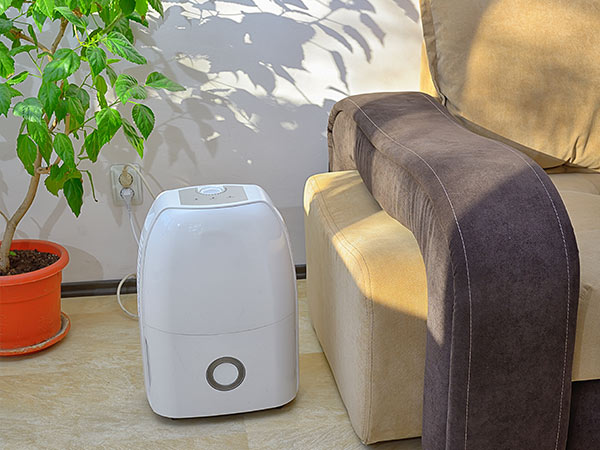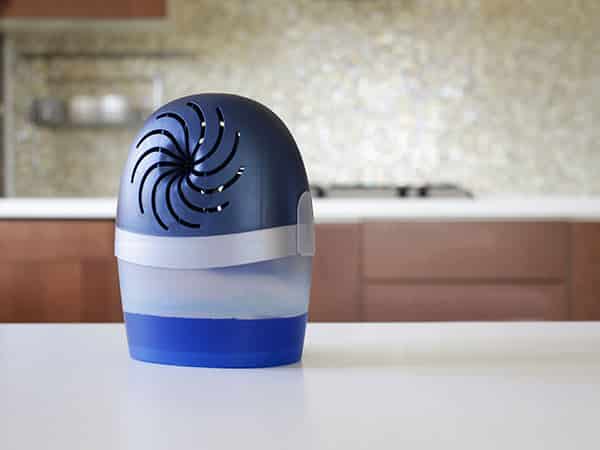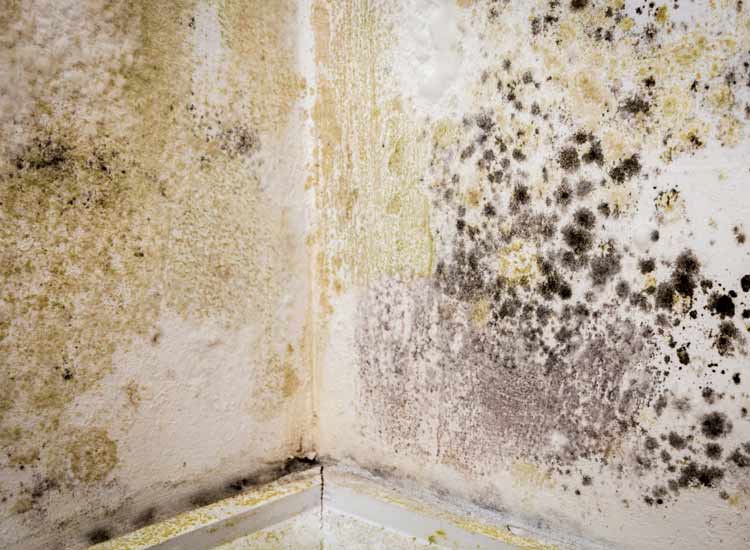Are Damp Dehumidifiers Effective at Removing Damp?

Damp dehumidifiers are perceived as a cheap and straightforward solution for damp problems such as condensation, mildew and black mould. While damp dehumidifiers can be an effective solution in some instances, in most cases it does not provide a long-term solution as it treats the symptom rather than the cause of the problem.
Tired of reading? Listen to this article!
We understand why these products can look appealing as they promise quick and most importantly cheap results. The important thing is to understand that using damp dehumidifier is more like plucking leaves when you need to cut the whole branch to solve the problem completely.
Our surveyors often notice damp dehumidifiers being placed in rooms affected by damp. Seeing so many homeowners contacting us after trying this method just proves that simple dehumidifiers cannot deal with the issue effectively. If they were so effective, we probably would not be called in the first place. Continue reading to learn how to get rid of condensation and mould once and for all.
How Does a Damp Dehumidifier Work?
To put it simply, dehumidifiers draw moisture laden air and extract the moisture using different methods. The two most frequently encountered types of dehumidifiers work by applying refrigeration or absorption principles. The suitability of these dehumidifiers varies depending on the environment as refrigeration is suitable for higher temperatures and absorption (desiccant) dehumidifiers are more effective at lower temperatures.
Refrigerant Dehumidifiers
These dehumidifiers draw warm air using an in-built electric fan. The air passes its cooling section containing pipes, compressor and a pump that circulates a coolant liquid through the pipes (coils). As the air passes these freezing pipes it cools and the moisture from the air starts to condense into water droplets. These droplets then run-down the pipes into a tray that then needs to be emptied or pumped out. The dehumidified air passes over the hot compressor unit and warms to a similar temperature as it was drawn in.
Absorption Dehumidifiers
As the name suggests, absorption or desiccant dehumidifiers utilise absorbent materials to extract moisture from the air. Opposite to refrigeration process that cools the air, desiccant dehumidifiers are designed to heat the absorbent material to extract the moisture. These dehumidifiers were designed to be used in lower temperatures such as basements or garages.

Can a Damp Dehumidifier Stop Condensation and Mould?
When it comes to condensation and mould, it is important to understand that both issues appear due to the same cause – high relative humidity. Moisture laden air tends to condense on cold surfaces which then creates perfect conditions for mould growth.If you are planning to use a dehumidifier to solve a high humidity issue, it is important to know what caused the humidity levels to rise in the first place. In most cases, the air becomes damp due to simple household activities such as drying your clothes indoors, using a shower, cooking or simply by you breathing. In other cases, condensation and mould might appear due to external defects that allow damp to penetrate the fabric of your property and create cold spots. Knowing what is causing dampness in your property will enable you to take the right action required to solve it.
Note that domestic dehumidifiers can only make a moderate impact on relative humidity and can only do so in rooms where the dehumidifier is present. Here at Richardson & Starling, we recommend more effective, long-term condensation control solutions that manage moisture levels across the whole property.

Will Dehumidifiers Dry Out Damp Walls?
Walls within your property can be affected by damp due to multiple reasons. Some of them are caused by your lifestyle or the number of people living in the property and the others are caused by structural defects that cannot be solved with a simple dehumidifier. It is important to know what is causing the problem as using a dehumidifier to solve damp caused by a structural defect will only make the situation worse.Problems that can cause damp walls:
Condensation – moisture from cooking, drying clothes or simply breathing is gathered in the air that then condenses on surfaces as the air cools. Rooms that are frequently affected by condensation are often affected by mould and mildew.
Penetrating damp – property defects such as damaged rainwater goods, defective roofing, defective or porous render and masonry, damp cavity wall insulation can allow rainwater to penetrate your property and damage your interior fabric. Properties affected by penetrating damp often display damp patches, flaky paint, or mould growth and can be seen on any area of the external walls or ceilings.
Rising damp – damp can also affect your property by rising from the ground. Every property should have a Damp proofing course (DPC), but if it is breached or damaged it can result in rising damp affecting the lower sections of your walls. If you notice damp marks rising to about 1 metre, you might be dealing with a rising damp problem. Walls affected by rising damp can be damp to touch and are often covered by black mould caused by condensation forming on the cold wall and sometimes show signs of salts on the plaster surface.As you can see there are quite a few reasons why your property walls might be damp. In most cases using a dehumidifier will only slightly reduce relative humidity and will not solve the problem you are dealing with. Dehumidifiers are very helpful if you are drying out an area after it has been flooded and the source of the flood has been removed.
Our PCA accredited and highly experienced damp surveyors can help you identify the damp cause and specify the right solution to get rid of it once and for all.Are you looking for an effective solution to solve condensation, mould and indoor air quality issues? Contact your local Richardson & Starling branch for free advice or arrange a property survey.
